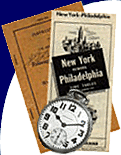I'll confess from the beginning that I've never personally visited the North Carolina Transportation Museum at Spencer, once the famous Southern Railway Spencer Shops. I have read Duane Galloway and Jim Wrinn's Southern Railway's Spencer Shops 1896-1996 (an excellent book), however, plus talked to a volunteer or two, and I've visited their website several times (www.nctrans.org), which has given me some idea of what's going on there. Also, I've watched the Museum's video Of Men and Machines numerous times, and I almost get a little misty when I hear the volunteer old timers (some probably now deceased) talking about how the shops were the lifeblood of the community, with as many as 2500 employees. Despite each man performing more than 40 years of hard labor there, their bonds of brotherhood to each other and the shops themselves obviously remained strong long after the facility was closed. Such was the culture of railroad life centered around the steam locomotive.
Since the video was made, much has been accomplished at Spencer. The grand opening of the 37-stall roundhouse on the 57-acre site was a major achievement, accomplished in September 1996, after an $8 million restoration. Though probably a good deal cleaner now than most anytime in its actual use, the building is impressive, and its salvation with ISTEA Enhancement funds is pretty amazing, considering the sad destruction so many other roundhouses have met. Just being able to spend that amount of transportation money on one preservation project is pretty amazing too. Between their paid help, contractors and loyal volunteers, they've restored two steam locomotives to operation, and done some nice cosmetic work on other equipment. This is not a slouch organization; they get things done there.
Commendations aside, however, the Museum's stated future goals and overall mission trouble me a bit. First, a word about their basic goal of being an all-encompassing transportation museum for the entire state of North Carolina. Doing so means they must cover a lot of territory, in terms of both mileage and subject.. The term transportation can be construed to mean just about anything from shoe leather to spacecraft. If this were all housed in a typical modern, sterile museum building, like the Smithsonian's Museum of American History, that would be no problem. But Spencer Shops is a historic site, related only to railroading, the Southern Railway in particular. Native Americans did not build dugout canoes here, nor did astronauts train for moon landings. Rail-wise, streetcars were not built or maintained here, nor were Seaboard Air Line 2-10-0s. This was a Southern Railway facility, as proudly proclaimed by the herald on their water tank. Its purpose was to maintain locomotives for the Southern Railway, with perhaps an occasional shortline or logging engine visiting for heavy repairs that could not be accomplished by the other road's limited facilities. The paychecks of the sweating workers who caulked staybolts, shoveled ashes and machined side rods said "Southern Railway", not Atlantic Coast Line, Piedmont Airlines or NASA; most of these workers spent their entire working lives here. Doesn't their toil deserve more recognition than a few mannequins and photos mounted on plywood display panels among other exhibits? Why not make the museum's mission "to restore and operate Spencer Shops in as close a manner to the way in which it once operated?" After all, it is a historic site, not just a new "big box" building. History actually happened here...
Secondly, the museum's plans for the future also concern me. A recent issue of Shop Talk, the newsletter put out by the museum's supporting "booster" foundation (also found on their website), outlines plans to stabilize, restore and utilize the huge 1907 backshop building, which is presently in poor repair and used only to shelter unrestored passenger cars from the weather. Text and drawings in that issue indicate plans for the "Back Shop of the Future: A gleaming museum that tells the story of transportation in North Carolina - from the beginning to the present". The artist's rendering shows a replica of the Wright Brothers first airplane, a DC3, and a Mercury space capsule suspended from the roof trusses. On the floor, interactive computerized video displays tell of other accomplishments in the state's transportation history. The museum's executive director states "We will be able to collect artifacts and present exhibits on trucking, aviation, highway construction past and future, race cars and other forms of inland transportation". What do these subjects have to do with a railroad backshop? And when did a railroad backshop ever gleam?
Some $3.2 million was expected from state funds to stabilize and restore the 160 x 600-foot building itself, and fundraising is planned to raise an additional $20 million to complete the exhibits, with an expected total cost of $25 million for the whole project. Though considerably less than what's been spent at Steamtown, that's still a lot of dough, even for a project of this magnitude.
A more recent update on the website indicates the back shop renovation campaign began on October 29, 1998, with a ceremony and various distinguished guests. Overall funding needs were raised slightly to $30 million. According to the report, "visitors were treated to a sneak peek of artists' renderings of the fully restored backshop, featuring vintage aircraft hanging from the ceiling, boats floating in a center pool, giant locomotives occupying a small portion of the structure's massive floor space, historical trucks and automobiles, a theater, classrooms, meeting rooms, and much more". In the report's next-to-last paragraph, the scene was described as the Museum's locomotive No. 604 (a former Buffalo Creek & Gauley 2-8-0) backed its train slowly past the backshop in the cool evening darkness: "Through the windows devoid of glass, you could almost see the ghosts of Southern Railway employees putting life back into that steam engine, hear the clanking of hammers and the turning of machinery, and smell the coal smoke as yet another locomotive was fired up after an overhaul and returned to the road." I'll bet those ghosts, showing up for work, would be surprised to find airplanes, space capsules and boats in place of their familiar machinery.
The original equipment from the backshop was sold or scrapped decades ago, of course, and the museum inherited only a big, empty, leaking building. The natural tendency for someone with a development background, or even with a museology education would be to envision such a space as a "great hall" for exhibits related to the museum's mission, or if commercially developed, as a giant area of boutiques, food courts and stores selling refrigerator magnets, ala' the trainshed of St. Louis Union Station. Restoration as a proper Southern Railway backshop would simply not be practical - or would it?
Consider that, when the Norfolk Southern ended its steam program a few years ago, much of the hardware needed to re-equip the Spencer backshop as a railroad backshop was available. Most of this machinery probably had Southern Railway heritage, and a piece or two might have even come from Spencer originally. But most of it found its way to a metal building in Arizona to maintain the locomotives of the Grand Canyon Railway. Apparently, not much consideration was ever given to acquiring it for the Spencer Shops. Even today, similar steam-era machinery can be found abroad in places like China and Poland, some of it made in the USA. Other appropriate machinery might be found at non-rail industrial facilities. With some research, effort and expense, it's likely the backshop could be re-equipped to pretty well replicate what used to be there, and probably well within their proposed restoration budget. One of the overhead cranes is still in place, and a replacement for the other could likely be found in an abandoned factory somewhere. To its credit, the museum has maintained the original scale house (for weighing locomotives) in operable condition.
Such a setting would be an ideal permanent location for one of the professional steam restoration experts to settle down in. By combining retirees and soot-blackened volunteers in Kromer caps and overalls, a portion of the once bustling workforce could be a assembled as well. Perhaps a local vocational or community college program could be developed for rail restoration, like that of the University of Scranton and Steamtown. While a rail restoration career does not promise a life of prosperity, it can provide skill development, plus a meaningful life experience and appreciation of the past, and such "enrichment" classes are common in community colleges.
Consider also that eleven former Southern Railway steam locomotives still exist, only one of them at Spencer. Certainly some of these would be more appropriate at Spencer. Some were once assigned here, including that magnificent No. 1401, the 4-6-2 entombed in the Smithsonian's Railroad Hall. An article on the PS-4 Pacifics in an old Trains magazine says it was assigned to Spencer in 1950, and apparently finished its active service there. Imagine blackened machinists, boilermakers, tinsmiths, pipefitters and laborers swarming over those locomotives in that backshop, restoring some of them to operation, with period tools where safe and practical. Some of these persons could be part of a "rail experience week" for which they would pay to participate in, like the Friends of the Cumbres & Toltec Scenic RR.
Additional revenue could come from an "engineer for an hour" program, wherein visitors would pay to learn to fire and hostle live steam or vintage diesel locomotives on the grounds. Such an experience might be the culmination of the "rail experience" week, or as payment for volunteer restoration labor. Looking at No. 1401 recently, I noticed it has perfect-looking wheel profiles. Could it have been one of those engines overhauled at the end of steam (possibly at Spencer), then never used? It's an impressive display in Washington, and even projects recorded steam locomotive sounds from within, but imagine if it were extricated, returned to Spencer and made operable for limited, gentle use; what would you pay to pull the throttle on an engine that powered FDR's funeral train?
Off-site community elements could provide more of the experience also. A small cafe across the street once patronized by shop workers recently closed; it could be restored to look as it did in the steam era and reopened to serve visitors and workers again. Authentic fare might include cornbread, ham and lima beans, not tofu and veggies. No doubt adjacent businesses could be restored to sell quality American and North Carolina-made goods. According to the Spencer Shops book, Spencer does have a historic district, some of which might be refined from just "nice old buildings" to a "trip in time" experience.
To me, the key for the proper development of Spencer Shops, as well as that of other significant historic railway sites, is to start with a philosophy which stresses authenticity. Colonial Williamsburg has done this with great success since its development in the 1920s, even to the point of "untidying" their elegant grounds a bit in recent years to more closely reflect Colonial life. Williamsburg purports to be nothing more than an accurate reflection of life in Virginia's first capitol, and it provides one of the most accurate living history experiences available anywhere.
Translated into railroad terms at Spencer and elsewhere, this might mean soot-blackening newly cleaned structures, dressing workers in period attire (to exclude one-size-fits-all baseball caps), hiding modern electrical devices (as in Spencer's turntable shanty), using incandescent rather than sodium-vapor lighting, and many other small details that help create a period setting. And a relatively precise time frame would be more effective than an overall 1830s-1990s theme.
A good time frame for Spencer Shops would probably be the early 1950s, when steam locomotives were still around, but diesels were making inroads. Numerous changes (described in the Spencer Shops book) were made to some roundhouse bays and the backshop at that time for diesel maintenance, and should be left that way to illustrate the differences. Railroading was still in its glory years during this time, and the industry still believed in itself, despite the government-subsidized threat from trucks. The equipment collection should be rationalized over time to exclude most non-Southern items and even Southern Railway pieces inappropriate to the time frame depicted. This could be accomplished via sales and trades, and by simply not acquiring those pieces that don't fit in. Certainly Spencer will never be exactly as it once was, but the goal, in my mind, should be toward authenticity instead of away from it.
And what of the other non-rail transportation exhibits? Why not put them in more appropriate homes also? This might mean developing, say, a vintage Ford museum in a downtown building which once housed such a dealership. Fire trucks might be displayed in old firehouses, old airplanes in old hangars, and so forth. Fortunately, battleships are too hard to move inland, so they seldom fit into plans for transportation museums. Frankly, I believe the idea of all-encompassing, generic transportation museums is a bit out-of-date. We already have several - why make another one?
Will any of this happen? Perhaps not, but it provides fodder for argument. It is not meant to denigrate anyone's accomplishments thus far, which at Spencer have been considerable, but only to provide thoughts for direction in the future. After all, those ISTEA and TEA-21 funds are, indirectly, ours too. What are your thoughts on this subject?
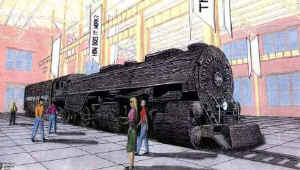 |
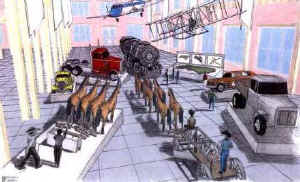 |
| As these artists renderings indicate, only a portion of the Spencer backshop will be devoted to railroads and locomotives. |
renderings from the North Carolina Transportation Museum website |
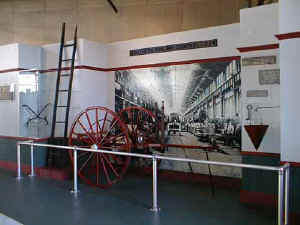 |
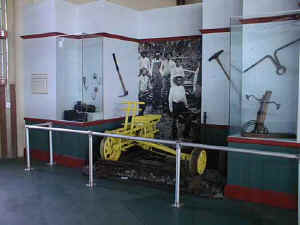 |
| Like other museums, Spencer has numerous static exhibits of old tools, equipment and photographs. While these are effective, they are less interesting to visitors than seeing the items in actual use. |
| photos from the North Carolina Transportation Museum website |

|
| Moving Southern Railway PS4 No. 1401 into the Smithsonian was no easy task. Once in place, the building was completed around it. Removing it would be an equally difficult, but not impossible task. |
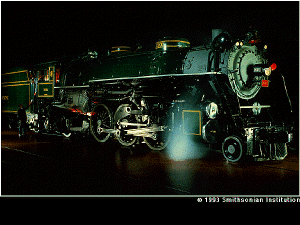 |
| Highball 1401! This photo was staged after dark right in the Smithsonian's Railroad Hall, but wouldn't it be something to see this Southern beauty restored for limited, gentle operation at the last roundhouse it called home? |
| photos from the Smithsonian Institute |
Author's note: Southern Railway's Spencer Shops, 1896-1996, is available from the North Carolina Transportation Museum's gift shop for $22.95. It is highly recommended, and a bargain. Purchasing a copy will help the Museum, and with a visit to their website, will allow the reader a detailed comparison of the "what was" at Spencer with their plans for the future. A new Spencer Shops video is available as well.




